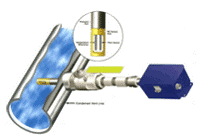

Condenser Instruments
RheoVac ® Condenser Performance Monitor
The RheoVac CM Condenser Monitor is the only instrument capable of analyzing the complex and dynamic nature of the mixture of non-condensable gases and water vapor in the condenser vent line.
This instrument is a true condenser monitor which provides continuous information on the operation of the condenser and air removal system. This allows immediate and positive differentiation between condenser air in-leak and adequacy of the exhauster capacity. The real-time monitoring of air in-leakage, exhauster capacity and other parameters to give you the information needed to identify small deficiencies and diagnose operating problems. Several other key condenser performance parameters are also measured which can be use in identifying some condenser configuration deficiencies.
RheoVac instruments can also be used to continuously monitor only air in-leakage if desired. Click here for more information on the RheoVac Air In-Leak Monitor.

What Are the Benefits?
The RheoVac CM Condenser Monitor is a unique multi-sensor instrument which provide real-time data to monitor the performance of your condenser and supports efforts to:
The RheoVac CM Condenser Monitor is a unique multi-sensor instrument which provide real-time data to monitor the performance of your condenser and supports efforts to:
- Quantify and locate air in-leak
- Detect tube fouling
- Reduce heat rate
- Lower fuel costs
- Recapture lost load
- Minimize chemical costs
- Increase availability
- Decrease corrosion
RheoVac Customer Comments and Experiences
How Do They Work?
RheoVac monitors use unique multi-sensor probes to measure or compute various parameters in the condenser exhaust line. The four primary sensors measure flow, temperature, pressure and relative saturation. The relative saturation sensor, which is unique to RheoVac instruments, directly measures water
vapor content within the fluid mixture. This additional data allows for refinement of the other measurements to provide the information on condenser operation described below.
An electronics unit, which includes the dedicated RheoVac processor, connects to one or more probes in the system. It displays the measured parameters locally, and provides an output, typically Ethernet, to bring all the data to the plant data acquisition system.

What Are the Key Data Outputs?
- Air in-leakage: continuously monitoring air in-leakage allows action to be taken before its rising value can affect back pressure. There is immediate feedback on efforts to reduce the air in-leak, and changes in air in-leakage can be correlated to other plant events. This is extremely useful in troubleshooting.
- Total mass flow and actual volumetric flow: these show the actual operating effectiveness of the vacuum equipment to remove air, other non-condensables and water vapor in comparison with the vacuum equipment’s performance curves. With this information you know if the pump (or ejector) is working properly.
- Water vapor-to-air mass ratio: this is a direct measurement of vacuum quality. Water vapor-to-air mass ratio precisely identifies the point at which excess back pressure will occur. Once there is excess back pressure, turning on an additional exhauster, or repairing air in-leaks, will reduce back pressure and save you money.

How Are They Installed?
The multi-sensor probes are installed, through supplied isolation ball valves, into the condenser vacuum pipes, between the condenser and the pumps or ejectors. Depending on generating unit size and pipe layout, one or more probes are used as shown in the drawing. The electronics unit can be located on the plant floor or remotely in the control room.
How do I Get a RheoVac system?
RheoVac systems are available for purchase or rent from Bionetics. Renting allows you to get the RheoVac monitor you need for the exact amount of time you need it, providing savings over purchasing a system to prove its value. Click here for more information on renting vs. purchasing a RheoVac system, or you can use the form on this page to request a quote.
Already own a RheoVac 950?
You can easily upgrade the system to monitor cooling water flow, fouling, and overall performance.
Click here to review the details of Bionetics’ Condenser Monitoring System.
- Provides direct reading of condenser air in-leak
- Measures actual exhauster capacity
- Quantifies excess back pressure
- On-line insertion through leak-tight ball valve assembly
- On-board sensor diagnostics
- Real time data is stored locally and can be routed to DCS
- Displays air in-leakage, water vapor to air mass ratio, total mass flow, temperature, pressure, relative saturation, and actual volumetric flow rate
| Temperature | Probe: 40° – 210 °F; Up to 400 °F optional Electronics: 40° – 120 °F |
| Pressure | 0.5 – 10” HgA |
| Calibration Accuracy | ± 5% of total mass flow |
| Repeatability | ± 1.5% of reading |
| Line Sizes | 3” through 18” |
| Process Connection | 1.5” ball valve assembly |
| Wetted Material | 316 Stainless steel probe; Engineered plastic probe tip (stainless steel optional for high temp) |
| Display | Backlit LCD |
| Enclosure | NEMA 4 |
| Outputs | Local display, Ethernet, RS-422/232, OPC, Modbus, and 4-20mA (optional) |
| Input Power | 100 – 250 VAC; 50 – 60 Hz |
Documents will open in new browser tab
|  | RheoVac Probe Installation Instructions | ||
|  | RheoVac Technical Note – Liquid Water in Vent Line User info required to download | ||
|  | RheoVac Technical Note – Multi-Probe System User info required to download | ||
|
Request a Quote

